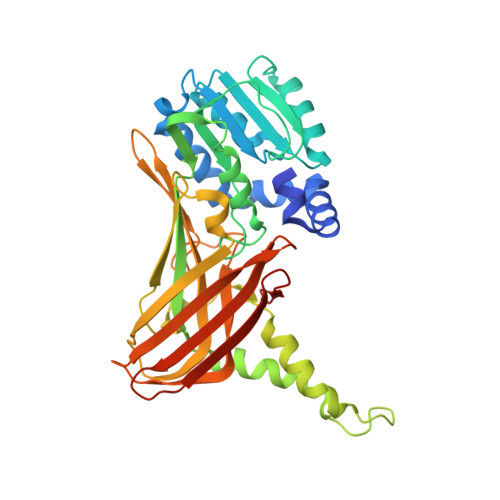Hijacking DNA methyltransferase transition state analogues to produce chemical scaffolds for PRMT inhibitors.
Halby, L., Marechal, N., Pechalrieu, D., Cura, V., Franchini, D.M., Faux, C., Alby, F., Troffer-Charlier, N., Kudithipudi, S., Jeltsch, A., Aouadi, W., Decroly, E., Guillemot, J.C., Page, P., Ferroud, C., Bonnefond, L., Guianvarc'h, D., Cavarelli, J., Arimondo, P.B.(2018) Philos Trans R Soc Lond B Biol Sci 373
- PubMed: 29685976
- DOI: https://doi.org/10.1098/rstb.2017.0072
- Primary Citation of Related Structures:
5LV2, 5LV3, 5LV4, 5LV5, 5TBH, 5TBI, 5TBJ - PubMed Abstract:
DNA, RNA and histone methylation is implicated in various human diseases such as cancer or viral infections, playing a major role in cell process regulation, especially in modulation of gene expression. Here we developed a convergent synthetic pathway starting from a protected bromomethylcytosine derivative to synthesize transition state analogues of the DNA methyltransferases. This approach led to seven 5-methylcytosine-adenosine compounds that were, surprisingly, inactive against hDNMT1, hDNMT3Acat, TRDMT1 and other RNA human and viral methyltransferases. Interestingly, compound 4 and its derivative 2 showed an inhibitory activity against PRMT4 in the micromolar range. Crystal structures showed that compound 4 binds to the PRMT4 active site, displacing strongly the S -adenosyl-l-methionine cofactor, occupying its binding site, and interacting with the arginine substrate site through the cytosine moiety that probes the space filled by a substrate peptide methylation intermediate. Furthermore, the binding of the compounds induces important structural switches. These findings open new routes for the conception of new potent PRMT4 inhibitors based on the 5-methylcytosine-adenosine scaffold.This article is part of a discussion meeting issue 'Frontiers in epigenetic chemical biology'.
Organizational Affiliation:
CNRS FRE3600 ETaC, bât. IBCG, 31062 Toulouse, France.
















